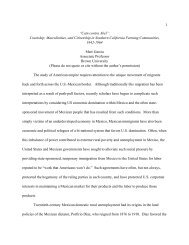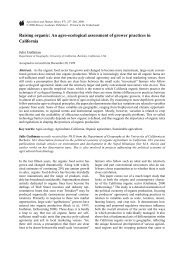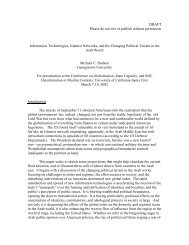The Death of Ramon Gonzalez and the 21st Century Dilemma
The Death of Ramon Gonzalez and the 21st Century Dilemma
The Death of Ramon Gonzalez and the 21st Century Dilemma
You also want an ePaper? Increase the reach of your titles
YUMPU automatically turns print PDFs into web optimized ePapers that Google loves.
governments. <strong>The</strong> big issues were about <strong>the</strong> control <strong>of</strong> money, real property, <strong>and</strong><br />
resources, not about trade per se. <strong>The</strong> results <strong>of</strong> NAFTA reflected this intention; between<br />
1994 <strong>and</strong> 2002, U.S. Foreign Direct Investment in Mexico grew by 259%, while trade<br />
growth attributable to NAFTA was quite modest, with <strong>the</strong> exception <strong>of</strong> such particular<br />
areas as corn exports to Mexico. Prior to NAFTA, barriers to industrial trade in most<br />
sectors were fairly low <strong>and</strong> were subject to a variety <strong>of</strong> exceptions, such as <strong>the</strong> maquila<br />
program encouraging manufacturing enterprises in Mexico financed by foreigners. Much<br />
<strong>of</strong> <strong>the</strong> debate over NAFTA was a bit hysterical in describing “<strong>the</strong> sucking sound <strong>of</strong> U.S.<br />
jobs going south.” Some manufacturing firms did move operations to Mexico <strong>and</strong> some<br />
manufacturing enterprises in <strong>the</strong> U.S. gained new markets in Mexico. <strong>The</strong> net effect on<br />
industrial employment on both sides, however, has been small. vi<br />
In agriculture, however, NAFTA brought some powerful changes that particularly<br />
affected peasant farmers. NAFTA negotiators proposed an immediate elimination <strong>of</strong><br />
many agricultural tariffs, including <strong>the</strong> high tariffs on U.S. grains entering <strong>the</strong> Mexican<br />
market. Some Mexican observers noted that this would mean that corn, or maize, grown<br />
on <strong>the</strong> superb <strong>and</strong> vast prairie soils <strong>of</strong> <strong>the</strong> U.S. Midwest in highly mechanized operations<br />
would flood Mexico with cheap corn <strong>and</strong> cause a collapse in small-scale Mexican corn<br />
production. Fur<strong>the</strong>r, under NAFTA’s terms, <strong>the</strong> Mexican government’s program to hold<br />
up producer prices <strong>of</strong> corn while providing subsidized, cheaper prices to urban people<br />
would have to be eliminated. Predictions <strong>of</strong> up to fifteen million people leaving <strong>the</strong> l<strong>and</strong><br />
due to <strong>the</strong> effect <strong>of</strong> tariff reductions on corn imported into Mexico led to an agreement to<br />
phase in <strong>the</strong> reductions over a fifteen-year period. In return, <strong>the</strong> United States government<br />
promised to eliminate subsidies to U.S. farmers, which would have moderated <strong>the</strong> effect





